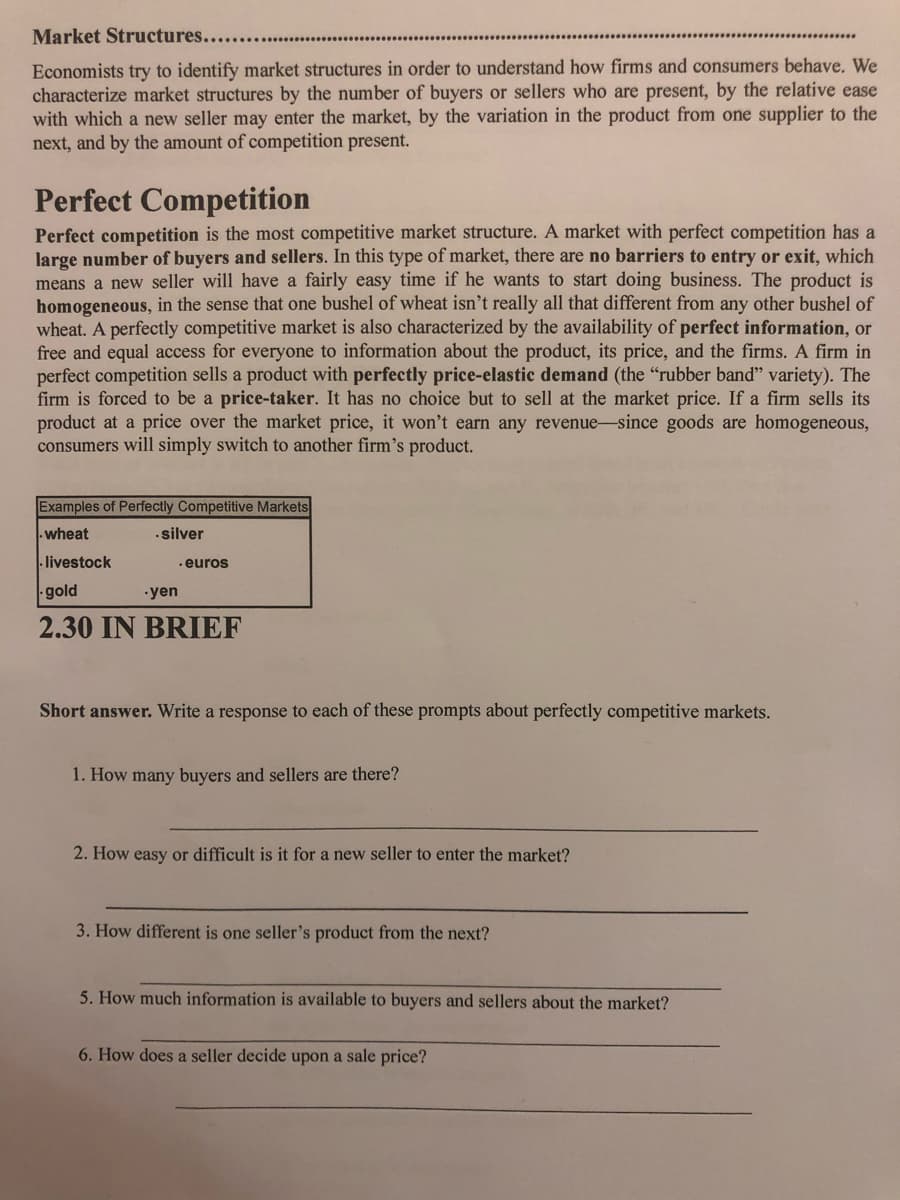Principles of Economics 2e
2nd Edition
ISBN:9781947172364
Author:Steven A. Greenlaw; David Shapiro
Publisher:Steven A. Greenlaw; David Shapiro
Chapter10: Monopolistic Competition And Oligopoly
Section: Chapter Questions
Problem 20P: May and Raj me the only two growers who provide organically grown corn to a local grocery store....
Related questions
Question

Transcribed Image Text:Market Structures...
Economists try to identify market structures in order to understand how firms and consumers behave. We
characterize market structures by the number of buyers or sellers who are present, by the relative ease
with which a new seller may enter the market, by the variation in the product from one supplier to the
next, and by the amount of competition present.
Perfect Competition
Perfect competition is the most competitive market structure. A market with perfect competition has a
large number of buyers and sellers. In this type of market, there are no barriers to entry or exit, which
means a new seller will have a fairly easy time if he wants to start doing business. The product is
homogeneous, in the sense that one bushel of wheat isn't really all that different from any other bushel of
wheat. A perfectly competitive market is also characterized by the availability of perfect information, or
free and equal access for everyone to information about the product, its price, and the firms. A firm in
perfect competition sells a product with perfectly price-elastic demand (the "rubber band" variety). The
firm is forced to be a price-taker. It has no choice but to sell at the market price. If a firm sells its
product at a price over the market price, it won't earn any revenue-since goods are homogeneous,
consumers will simply switch to another firm's product.
Examples of Perfectly Competitive Markets
-wheat
•silver
livestock
. euros
gold
•yen
2.30 IN BRIEF
Short answer. Write a response to each of these prompts about perfectly competitive markets.
1. How many buyers and sellers are there?
2. How easy or difficult is it for a new seller to enter the market?
3. How different is one seller's product from the next?
5. How much information is available to buyers and sellers about the market?
6. How does a seller decide upon a sale price?
Expert Solution
This question has been solved!
Explore an expertly crafted, step-by-step solution for a thorough understanding of key concepts.
This is a popular solution!
Trending now
This is a popular solution!
Step by step
Solved in 2 steps

Knowledge Booster
Learn more about
Need a deep-dive on the concept behind this application? Look no further. Learn more about this topic, economics and related others by exploring similar questions and additional content below.Recommended textbooks for you

Principles of Economics 2e
Economics
ISBN:
9781947172364
Author:
Steven A. Greenlaw; David Shapiro
Publisher:
OpenStax

Economics: Private and Public Choice (MindTap Cou…
Economics
ISBN:
9781305506725
Author:
James D. Gwartney, Richard L. Stroup, Russell S. Sobel, David A. Macpherson
Publisher:
Cengage Learning

Microeconomics: Private and Public Choice (MindTa…
Economics
ISBN:
9781305506893
Author:
James D. Gwartney, Richard L. Stroup, Russell S. Sobel, David A. Macpherson
Publisher:
Cengage Learning

Principles of Economics 2e
Economics
ISBN:
9781947172364
Author:
Steven A. Greenlaw; David Shapiro
Publisher:
OpenStax

Economics: Private and Public Choice (MindTap Cou…
Economics
ISBN:
9781305506725
Author:
James D. Gwartney, Richard L. Stroup, Russell S. Sobel, David A. Macpherson
Publisher:
Cengage Learning

Microeconomics: Private and Public Choice (MindTa…
Economics
ISBN:
9781305506893
Author:
James D. Gwartney, Richard L. Stroup, Russell S. Sobel, David A. Macpherson
Publisher:
Cengage Learning